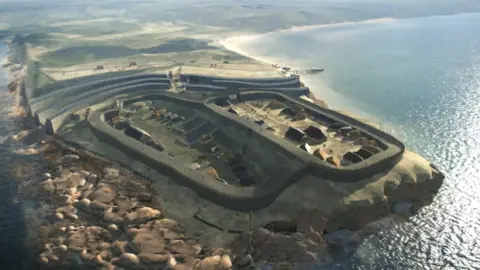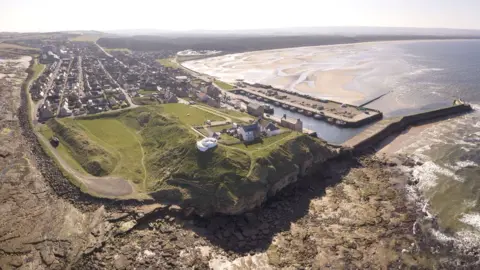Is this how a Pictish fort looked 1,000 years ago?
 University of Aberdeen/Dundee
University of Aberdeen/DundeeA three-dimensional reconstruction has depicted how a significant Scottish Pictish fort may have looked more than 1,000 years ago.
Images of Burghead Fort in Moray have been created based on excavations by the University of Aberdeen.
It is thought the settlement was a significant seat of power within the Pictish kingdom between AD500 and AD1000.
The team said the reconstruction offered an "amazing insight".
Funded by Historic Environment Scotland as part of a wider project, the reconstruction shows enormous defensive ramparts which were once thought to be 8m (26ft) thick and 6m (20ft) high, as well as dwellings within the fort.
 University of Aberdeen/Dundee
University of Aberdeen/DundeeUniversity of Aberdeen archaeologists first began the excavations in 2015.
Prof Gordon Noble, who leads the team, said their discoveries in the years since had enabled a detailed reconstruction of how the site may have looked.
"The scale of houses and buildings we have discovered evidence of show that this was a densely populated and important Pictish site", he said.
'Dramatic and imposing'
"From metalworking to weaponry and even hair and dress pins, with each new dig we are finding out more about our ancestors who lived here. The foundations of the huge ramparts have survived far better than anyone anticipated.
"It is wonderful to see the work of our excavations spanning more than five years brought together in these stunning reconstructions which offer an amazing insight into how Burghead may have looked."
Dr Kevin Grant, the archaeology manager of Historic Environment Scotland said the fort at Burghead was one of the most important places in early Medieval Scotland, and was built to be "dramatic and imposing".
He said: "These reconstructions help us imagine experiencing this spectacular site in its hey-day. We are also delighted to support these excavations, which are transforming our understanding of Pictish Scotland and saving important archaeological remains from being lost to the waves."
The reconstruction was co-ordinated by Dr Alice Watterson of the University of Dundee with members of the 3DVisLab research group.
